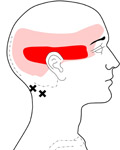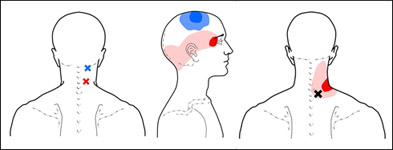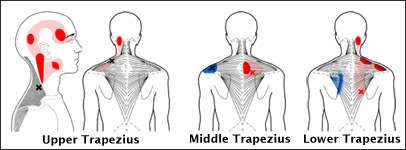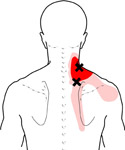When you have pain in the back of your neck, a lot of the discomfort comes from stiffness in the muscles themselves and some comes from Trigger Point referrals. Some of the neck muscles refer pain right to the neck while others refer symptoms away from the neck. Trigger Point analysis can help you understand which specific muscles are more dysfunctional by feeling where else besides your neck you feel symptoms, then narrowing down the muscles that refer to that spot to the one that might be in trouble. For instance, if you have posterior neck pain AND pain at the top of your head, you’ll find that there are only two muscles that refer to the vertex and only one that is a posterior cervical muscle. Therefor you can be more effective in treating the neck pain by knowing which specific muscle to target.
(information is synthesized from the medical text by Drs. Travell and Simons, Myofascial Pain and Dysfunction: The Trigger Point Manual, Vol I, Second Edition)

Suboccipitals:
Referred pain feels like a headache that starts at the base of the skull (occiput) and goes everywhere inside the head with some pain into the forehead and eye.
Splenius capitis and cervicis:
 Pain from the splenius capitis refers to the top of the head.
Pain from the splenius capitis refers to the top of the head.
The splenius cervicis is more complicated:
Trigger Points from near the head where it attaches to the vertebrae usually cause a headache similar to the suboccipitals but more with a feeling of going directly through the head with a strong pain behind the eye. Blurry vision can be associated with these upper TrPs.
Trigger Points from lower in the muscle (in the “pocket” over the ribs) are felt mostly at the angle of the neck with pain going up the back of the neck to the base of the skull or down into the shoulder. Symptoms can also feel like pressure or numbness.
Posterior cervical muscles:
 Semispinalis (mostly s.capitis portion) refers pain from the upper portion that feels like a headband with a focus at the temples. The middle portion goes to the back of the skull.
Semispinalis (mostly s.capitis portion) refers pain from the upper portion that feels like a headband with a focus at the temples. The middle portion goes to the back of the skull.
Longissimus capitis refers pain mostly around the ear. Some referrals go nearby into the neck and up behind the eye.
Multifidi refer primarily under the base of the skull and sometimes down the middle of the neck toward the shoulder blade. Pain is usually pretty localized.
Rotatores are the deepest muscles and refer pain the most locally, usually right at the spine.
Trapezius:
 Upper trapezius Trigger Point #1 is the most common TrP in the body. It refers classically in a question mark pattern up the back side of the neck to the skull then around behind the ear to the temples. It can extend into the eye. It can also be included in TMJ pains when it refers to the angle of the jaw. Interesting is occasional symptoms of dizziness!
Upper trapezius Trigger Point #1 is the most common TrP in the body. It refers classically in a question mark pattern up the back side of the neck to the skull then around behind the ear to the temples. It can extend into the eye. It can also be included in TMJ pains when it refers to the angle of the jaw. Interesting is occasional symptoms of dizziness!
Middle trapezius TrPs occur 1) at it’s attachment to the bones near the tip of the shoulder (acromion) where it produces aching pain, and 2) in the upper back where it produces superficial burning pain from the spine to the area around the upper inside edge of the shoulder blade (scapula).
Lower trapezius TrPs are very important and often overlooked. The one just off the middle of the lower edge of the scapula especially so. It refers strongly to the back of the neck just under the skull and behind the ear. Secondarily it refers strongly to the tip of the shoulder. Additional referrals feel like a deep ache and soreness in the upper back and shoulder. It’s other TrP is where it attaches to the scapula. Pain is described as “steady burning pain” all along the inside edge of the shoulder blade.
 Levator scapula:
Levator scapula:
These TrPs are considered “one of the most important causes of neck pain or neck and shoulder pain” and “stiff neck”(Travell p.491) and they are the second most frequently occurring TrPs in the body behind the upper trapezius. It’s primary referral is to the angle of the neck. Secondarily it refers all along the inside border of the scapula and out into the back of the shoulder and top of the arm.
The next post will give you self-treatment tips for these muscles.
It’s interesting that tension headaches can actually be caused by stiff muscles and trigger points in your neck. I know for myself that sitting at a computer all day can cause tension and triggers if I’m not careful with my posture.
Thanks for the info!
OMG, I saw myself in those pictures! At the moment i am struggling to find out what sort of pain i have for 6 months. I have been to the orthopedist in Brazil and he investigated my cervical spine and asked me for 3 different exams: x-ray, ultrasound and resonance magnetic. Nothing wrong with the spine and he concluded I have myofacial headache and recommended 10 sessions of physio. I spoke to another Ortho doctor from USA, a friend of mine and he advised me to see a Neurologist to sort out my headaches. The GP doctor in UK unfortunately hasn’t been too helpful and keeps sending me home with tablets. I am so nervous and can’t stand this pain for longer. Thanks for the info u posted. I am printing it today to show the GP doctor how I feel and see what he says this time. They don’ take ppl’s pain seriously in GP’s. Thanks and have a wonderful day!!
If you’re in the UK, check out Westminster College in London. They teach clinical application of Neuromuscular Therapies there, so you may be able to get advice and treatment.
Christina,
Thank you for the perfect image of my splenius capitis headache; it covers my entire head and forehead. After a whiplash car accident, tried chiropractic, massage, muscle stimulator, acupuncture, muscle relaxants and finally, a C4-7 discectomy and fusion–the only thing that helps is to try and keep moving with yoga stretches and a fantastic massage therapist who knows exactly which muscle needs the most attention!